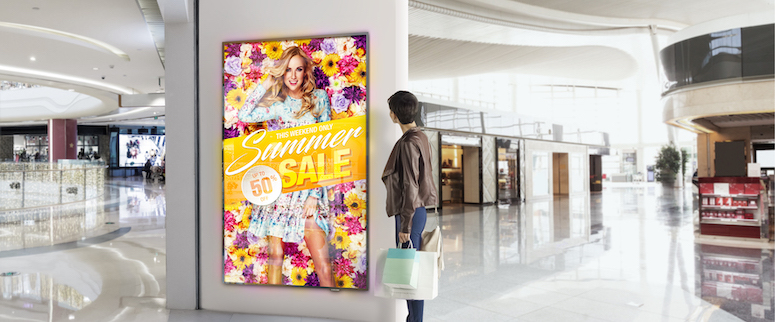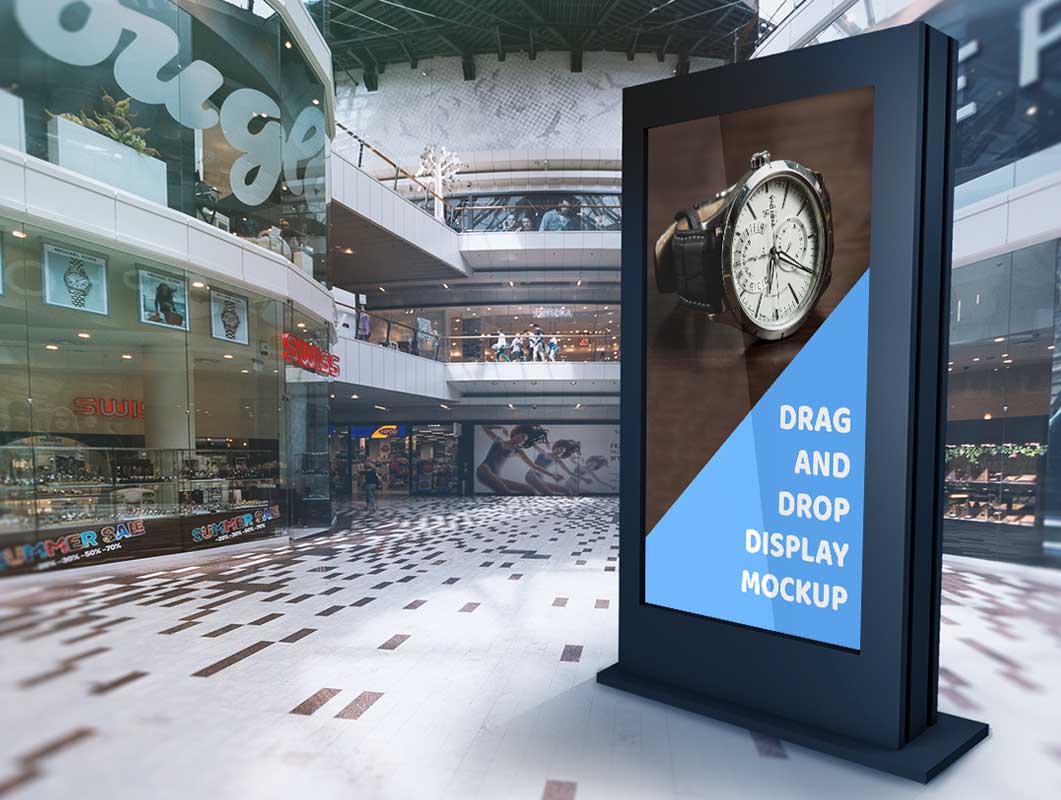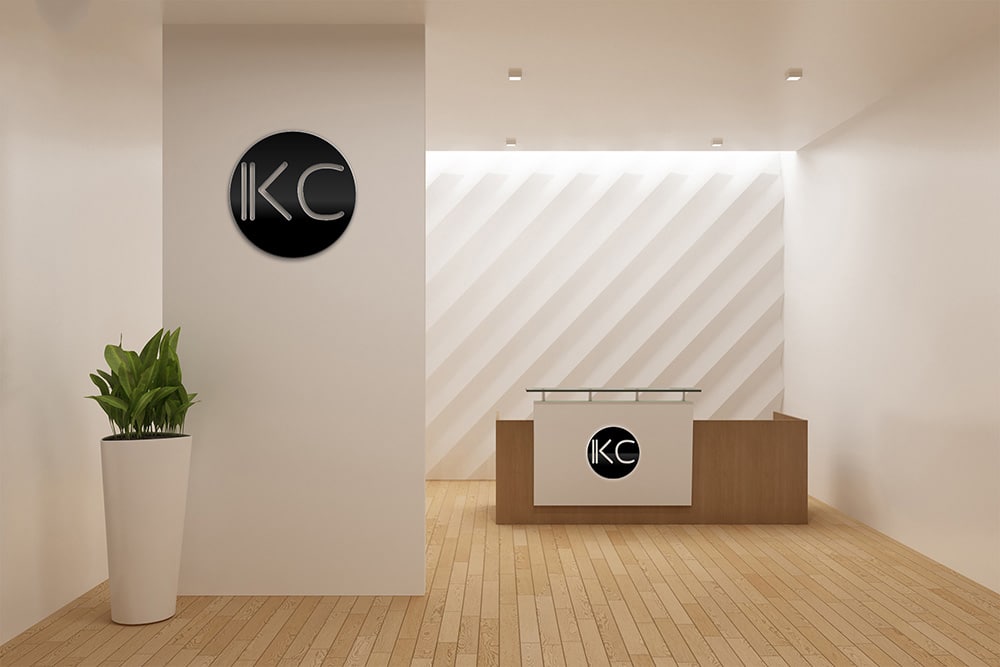Types of signage in retail store
 There are several types of shop signage design that are commonly used in retail stores to communicate information, promote products, and enhance the overall shopping experience for customers. Some common types of signage in retail stores include:
There are several types of shop signage design that are commonly used in retail stores to communicate information, promote products, and enhance the overall shopping experience for customers. Some common types of signage in retail stores include:
- Exterior Signage: These signs are located outside the retail store and are used to attract customers from the street or other public areas. They typically include the store’s name, logo, and sometimes additional information such as store hours or promotions.
- Window Signage: These signs are placed on the windows of the store and can be used to promote sales, discounts, or new products. They can also provide information about store policies, such as returns or exchanges.
- Aisle Signage: These signs are placed in the aisles of the store and provide information about the products available in that particular section. They can help customers navigate the store and find what they are looking for.
- Department Signage: These signs are placed above or near specific departments or sections in the store, such as “Women’s Clothing” or “Electronics.” They can help customers quickly identify different sections of the store and locate specific types of products.
- Point-of-Sale (POS) Signage: These signs are placed near the cash registers or checkout counters and are used to promote last-minute purchases or special offers, such as “Buy One, Get One Free” or “Limited Time Offer.”
- Shelf Edge Signage: These signs are attached to the edges of store shelves and provide information about the products on the shelves, such as pricing, promotions, or product features.
- Floor Signage: These signs are placed on the store floor and can be used to guide customers to different areas of the store, highlight special promotions or events, or provide directions.
- Digital Signage: These signs use digital displays, such as LCD screens or LED panels, to show dynamic content such as videos, images, or scrolling messages. They can be used to promote products, convey brand messages, or provide real-time information about sales or promotions.
- Banners and Posters: These larger signs are typically hung from the ceiling, mounted on walls, or displayed on stands and can be used to promote sales, seasonal offers, or other marketing messages.
- Wayfinding Signage: These signs are designed to help customers navigate through the store and find their way to different areas, such as restrooms, fitting rooms, or exits. They typically include directional arrows, symbols, or maps to guide customers.
These are some of the common types of shop signage that you may find in a retail store. The specific types of signage used in a retail store may vary depending on the store’s size, layout, and branding, as well as the products or services being offered. Effective signage can play a crucial role in attracting customers, conveying information, and enhancing the overall shopping experience.
Signage shop drawings
 Here a sample template for shop signs drawing. Please note that shop drawings are typically prepared by professional drafters or engineers with expertise in signage design and fabrication. It’s important to consult with a qualified professional for accurate and compliant shop drawings for your specific signage project.
Here a sample template for shop signs drawing. Please note that shop drawings are typically prepared by professional drafters or engineers with expertise in signage design and fabrication. It’s important to consult with a qualified professional for accurate and compliant shop drawings for your specific signage project.
Here’s a basic template for a signage shop drawing:
Title Block:
- Include the project name, location, and drawing number for your shop signage design.
- Add the date of drawing creation and revision number, if applicable.
- Include the name and contact information of the drafting company or drafter.
General Notes:
- Provide general notes specifying fabrication details, materials, and finishes.
- Include any specific instructions or requirements for fabrication and installation.
Drawing Views:
- Include plan views, elevations, and sections as needed.
- Show the dimensions, scale, and orientation of the drawing.
- Clearly indicate the location of the signage on the drawing.
Signage Details:
- Provide detailed drawings of each signage component, including dimensions, materials, and finishes.
- Include details of the lettering, graphics, lighting, and mounting method.
- Specify any necessary electrical requirements, such as wiring, transformers, and power sources.
Bill of Materials:
- Provide a comprehensive list of all materials and components required for fabrication.
- Include the quantity, description, and part numbers of each item.
- Specify any special instructions or notes related to the materials and components.
Legend:
- Include a legend that explains the symbols, abbreviations, and notations used in the drawing.
- Provide a clear and concise key for easy reference.
Revision History:
- Keep a record of all revisions made to the drawing, including revision dates and descriptions.
- Maintain a revision history log to track changes throughout the project.
Note: This is a basic template and may need to be customized to meet the specific requirements of your signage project. It’s important to work with a qualified professional and adhere to local building codes and regulations when preparing signage shop drawings.
Why digital signage is important
 Shop sign designs is important for several reasons:
Shop sign designs is important for several reasons:- Enhanced Communication: Digital signage allows for dynamic, engaging, and visually appealing content that can effectively convey information and messages to a wide audience. It can be used to display announcements, news, advertisements, wayfinding, and other important communications in real-time, making it a powerful tool for communication in various settings such as businesses, schools, hospitals, transportation hubs, and public spaces.
- Improved Customer Experience: Digital signage can enhance the overall customer experience by providing relevant and timely information. For example, in retail settings, digital signage can display product information, promotions, and personalized offers, creating an interactive and immersive shopping experience for customers. In restaurants, digital menu boards can showcase enticing food images and special offers, leading to increased sales. In transportation hubs, digital signage can provide real-time travel information, helping passengers navigate through the facility and stay informed about their travel plans.
- Cost-effective and Flexible: Digital signage provides a cost-effective solution compared to traditional static signage, as it eliminates the need for printing and manual updating of content. With digital signage, content can be remotely managed and updated in real-time, allowing for quick and easy changes to be made. This flexibility makes it adaptable to changing needs and requirements, and it can be used for various purposes, such as advertising, branding, information dissemination, and emergency messaging.
- Increased Engagement: Digital signage is highly engaging due to its dynamic and visually appealing nature. It captures attention and holds viewers’ interest, making it an effective medium for conveying messages and influencing behavior. Digital signage can be used to display multimedia content such as videos, images, animations, and interactive touchscreens, providing an immersive experience that can drive higher customer engagement, brand awareness, and ultimately, better results.
- Analytics and Data-driven Insights: Digital signage can provide valuable analytics and data-driven insights that can help businesses measure the effectiveness of their content and campaigns. This data can include metrics such as impression counts, dwell times, and click-through rates, which can be used to optimize content, understand customer behavior, and make data-driven decisions to improve the overall performance of digital signage initiatives.
In conclusion, digital signage is important as it enhances communication, improves customer experience, provides cost-effective and flexible solutions, increases engagement, and provides valuable analytics and data-driven insights. It is a powerful tool that can be used in various settings to effectively convey messages, engage audiences, and drive desired outcomes.
What is signage in graphic design
 Shop signs designs in graphic design refers to the visual elements and graphics that are used to convey information, promote a brand or message, and guide people in public spaces. Signage can be found in various forms, including outdoor and indoor signs, wayfinding signs, directional signs, safety signs, and promotional signs. Signage in graphic design typically involves the use of typography, color, imagery, symbols, and other visual elements to create visually appealing and effective communication tools.
Shop signs designs in graphic design refers to the visual elements and graphics that are used to convey information, promote a brand or message, and guide people in public spaces. Signage can be found in various forms, including outdoor and indoor signs, wayfinding signs, directional signs, safety signs, and promotional signs. Signage in graphic design typically involves the use of typography, color, imagery, symbols, and other visual elements to create visually appealing and effective communication tools.
Signage in graphic design serves several purposes, including providing information, creating brand recognition, enhancing the aesthetic appeal of a space, and guiding people to their desired destinations. It is an important aspect of environmental graphic design, which focuses on creating visual solutions for the built environment to improve navigation, communication, and overall user experience.
Graphic designers who work on signage projects need to consider factors such as the intended audience, location, context, visibility, legibility, and durability of the signs. They also need to ensure that the signage adheres to any relevant regulations or guidelines, such as accessibility requirements, safety standards, and local zoning laws. Effective signage in graphic design can greatly impact how people perceive and interact with a space, making it an essential aspect of environmental design and visual communication.
How to design signage
 Design shop sign involves careful consideration of various elements to create effective and visually appealing signs. Here are some steps to help you design signage:
Design shop sign involves careful consideration of various elements to create effective and visually appealing signs. Here are some steps to help you design signage:- Define the Purpose: Determine the purpose of the signage. Is it for wayfinding, advertising, information, or safety? Understanding the purpose of the sign will help you determine the appropriate design elements.
- Know the Audience: Consider the target audience for the signage. Who will be viewing the sign, and what are their characteristics, preferences, and needs? This will help you tailor the design to resonate with the intended audience.
- Choose the Right Type of Sign: There are various types of signs, such as indoor signs, outdoor signs, directional signs, informational signs, and promotional signs. Choose the appropriate type of sign based on its intended location and purpose.
- Keep it Simple: Simplicity is key in signage design. Avoid cluttered designs and excessive text. Use concise messages, clear fonts, and minimal colors to create a clean and easy-to-read sign.
- Use Appropriate Colors: Choose colors that are visually appealing and align with the purpose of the sign. Consider the psychology of colors and how they may impact the emotions and perceptions of the viewers.
- Consider Visibility: Consider the viewing distance, angle, and lighting conditions of the sign’s location. Choose font sizes, colors, and contrast that ensure the sign is easily visible and readable from a distance.
- Incorporate Branding: If the signage is for a business or organization, consider incorporating branding elements, such as logos, colors, and fonts, to maintain consistency and reinforce brand recognition.
- Use High-Quality Graphics and Images: If using graphics or images, ensure they are of high quality and relevant to the sign’s purpose. Avoid pixelated or low-resolution images that may appear blurry or unprofessional.
- Test for Legibility: Before finalizing the design, test the sign’s legibility by reviewing it from different distances and angles. Make adjustments as needed to ensure that the sign is easy to read and understand.
- Follow ADA Guidelines: If designing signs for public spaces, such as in buildings or public areas, ensure that they comply with the Americans with Disabilities Act (ADA) guidelines. ADA-compliant signs should have appropriate fonts, sizes, contrast, and accessibility features for people with disabilities.
Remember that effective signage should communicate its message quickly and clearly to the viewers. By considering the purpose, audience, simplicity, visibility, branding, and other key design elements, you can create signage that effectively conveys its intended message and enhances the overall visual appeal of the space.
How important is signage for a business
 Signage is an essential element for any business as it plays a critical role in conveying information, establishing branding, attracting customers, and promoting products or services. Here are some key reasons why signage is important for a business:
Signage is an essential element for any business as it plays a critical role in conveying information, establishing branding, attracting customers, and promoting products or services. Here are some key reasons why signage is important for a business:- Branding: Signage is an effective tool for establishing and reinforcing a business’s brand identity. A well-designed sign with the business logo, colors, and fonts helps create brand recognition and recall among potential customers, which can lead to increased brand loyalty and trust.
- Visibility and Attraction: Signs serve as visual cues that help businesses stand out and attract attention in a competitive market. An eye-catching sign with clear messaging and appealing design can draw potential customers to a business, increasing foot traffic and generating leads.
- Information and Navigation: Signs provide important information to customers, such as business name, address, operating hours, contact information, and directional guidance. Clear and informative signage can help customers easily locate and navigate a business, enhancing their experience and improving customer satisfaction.
- Advertising and Promotion: Signs can be a cost-effective form of advertising for businesses. They can effectively promote products, services, sales, or special offers, creating awareness and generating interest among potential customers. Well-designed signs can also serve as a constant reminder to customers about a business’s offerings.
- Professionalism and Credibility: A well-designed sign reflects the professionalism and credibility of a business. It gives the impression that the business is established, reliable, and trustworthy, which can help build customer confidence and attract more business.
- Differentiation: Signage allows businesses to differentiate themselves from competitors by showcasing their unique value proposition, offerings, or brand personality. A distinctive and memorable sign can help a business stand out in a crowded market and leave a lasting impression on customers.
In summary, signage is crucial for businesses as it enhances branding, visibility, information provision, advertising, professionalism, and differentiation. It serves as a powerful marketing tool that can help businesses attract customers, promote products or services, and establish a strong brand presence in the market.
Shop Signage Design FAQs
Q: How crucial is shop signage for small businesses? A: Shop signage is paramount for small businesses, acting as the first point of contact with potential customers. It establishes brand identity, attracts foot traffic, and sets the tone for the overall customer experience.
Q: Should shop signage be updated regularly? A: Yes, periodic updates keep your signage relevant and aligned with evolving business goals. It’s essential to stay current with design trends and ensure your signage reflects any changes in your brand image.
Q: What role does contrast play in signage design? A: Contrast enhances visibility and readability. Choosing contrasting colors and fonts ensures that your signage stands out, even in crowded urban environments.
Q: How can businesses maintain brand consistency in signage? A: Consistency in colors, fonts, and messaging across all signage materials, both physical and digital, is crucial. This creates a cohesive brand image that customers can easily recognize and trust.
Q: Are there specific regulations for shop signage design? A: Yes, local regulations may dictate size, placement, and illumination of shop signage. It’s essential to comply with these regulations to avoid fines and ensure a positive relationship with local authorities.
Q: Can illuminated signage save energy with modern technology? A: Absolutely. LED technology has revolutionized illuminated signage, offering energy-efficient options that reduce operational costs while maintaining the visual appeal of your storefront.
Conclusion
In the competitive business landscape, a well-crafted shop signage design is not just an accessory; it’s a strategic tool for success. By understanding the nuances of design, staying updated on trends, and infusing local flavor, businesses can create a visual identity that resonates with their target audience.

